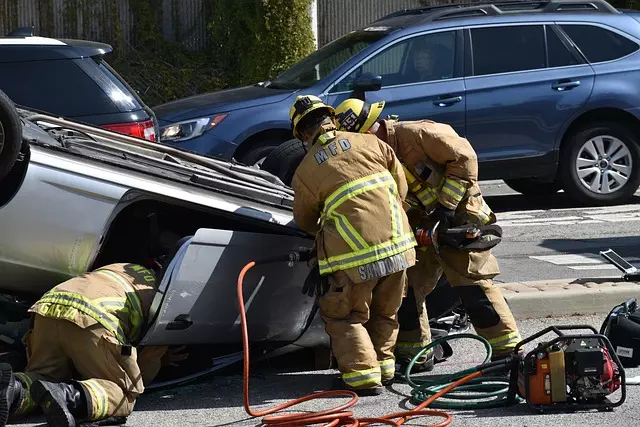Allergic reactions range from mild to severe and can be managed with prompt first aid, especially in cases of anaphylaxis. Two main types exist, requiring different approaches. Basic Life Support (BLS) training, including CPR, is crucial for bystanders to stabilize individuals until professional help arrives. Individuals with allergies should carry epinephrine auto-injectors, and first aid certification should be obtained and regularly renewed to ensure preparedness.
In today’s world, understanding allergic reactions and how to provide effective first aid is crucial. This comprehensive guide delves into the essentials of recognizing and managing allergy symptoms, from mild to severe. We explore various types of allergic reactions, highlighting when and how to intervene with basic first aid techniques, including CPR and Basic Life Support (BLS). Additionally, we dissect the importance of formal first aid certification requirements for individuals aiming to become proficient in responding to allergy emergencies.
- Understanding Allergic Reactions: Symptoms and Types
- When to Provide First Aid for Allergies
- Basic First Aid Techniques for Allergic Reactions
- CPR and Basic Life Support in Allergy Cases
- Certification Requirements for First Aid Training in Allergies
Understanding Allergic Reactions: Symptoms and Types
Allergic reactions occur when your body’s immune system overreacts to a substance that it mistakes as harmful, leading to a range of symptoms. Understanding these reactions and their varying types is crucial for anyone seeking first aid and CPR training. Symptoms can range from mild, such as hives or itching, to severe, including difficulty breathing, dizziness, and anaphylaxis – a life-threatening condition.
There are two primary types: immediate (type 1) reactions, which involve the release of histamine and typically occur within minutes of exposure to the allergen; and delayed (type 4) reactions, which are less common but can cause chronic skin conditions like eczema or contact dermatitis. Basic life support training teaches individuals how to recognize these symptoms and respond appropriately, while understanding first aid certification requirements empowers people to provide crucial care until professional help arrives.
When to Provide First Aid for Allergies
Knowing when to provide first aid for allergies is crucial, especially with the increasing prevalence of allergic reactions. If you suspect someone is experiencing an allergic reaction—whether it’s due to food, pollen, or another trigger—it’s important to act quickly. Basic life support training and first aid certification can equip individuals with the skills needed to handle these emergencies effectively.
Individuals with a history of allergies or those who have previously experienced severe reactions should always carry an epinephrine auto-injector (e.g., EpiPen) on their person. If you witness someone experiencing symptoms like hives, swelling, difficulty breathing, or an abrupt drop in blood pressure, immediately call for emergency services and provide first aid until help arrives. Basic life support training, including CPR, can be a lifesaver in these situations, ensuring that the individual receives critical care promptly.
Basic First Aid Techniques for Allergic Reactions
In the event of an allergic reaction, quick thinking and proper first aid can make a significant difference in managing symptoms and potentially saving lives. Basic First Aid Techniques for Allergic Reactions include staying calm and assessing the situation, moving the affected individual to a safe, open area if possible, and removing any visible sources of allergens. Administering epinephrine (adrenaline) auto-injectors, such as EpiPens®, is crucial in severe cases, as it can rapidly reverse life-threatening symptoms like anaphylaxis.
First aid and CPR training, including Basic Life Support (BLS), equips individuals with the skills to handle allergic reactions effectively. Basic life support training focuses on recognizing and responding to respiratory and circulatory emergencies, which are common in severe allergic reactions. Understanding first aid certification requirements and maintaining up-to-date skills through regular recertification ensures that you’re prepared when an emergency arises.
CPR and Basic Life Support in Allergy Cases
In the event of a severe allergic reaction, knowledge of CPR (Cardiopulmonary Resuscitation) and Basic Life Support (BLS) can be life-saving. First aid and CPR training equips individuals with crucial skills to manage such emergencies effectively. Understanding how to perform BLS, including chest compressions and airway management, is essential in keeping the affected individual stable until medical professionals arrive. These life-saving techniques are a fundamental component of first aid certification requirements, ensuring that individuals can respond appropriately in various situations.
Having basic life support training allows bystanders to provide critical care when someone experiences an allergic reaction, such as anaphylaxis. This includes recognizing the signs and symptoms, administering epinephrine (if available), and implementing CPR if breathing stops or becomes irregular. Regular first aid and CPR training updates are essential to stay prepared and confident in handling these urgent situations until professional medical help arrives.
Certification Requirements for First Aid Training in Allergies
Obtaining proper certification for first aid and CPR training is essential when dealing with allergic reactions. Many courses now include specific modules on recognizing and managing allergic emergencies, including anaphylaxis. These programs equip individuals with the skills to respond quickly and effectively in life-threatening situations. Certification requirements vary by region, but typically involve successful completion of a recognized course that covers basic life support (BLS) techniques, CPR, and allergy-specific interventions.
First aid certification courses ensure that participants learn not only theoretical aspects but also hands-on skills. Students practice administering epinephrin autoinjectors, performing rescue breathing, and providing other critical care measures. Upon completion of the training, individuals receive a certificate valid for a specified period, usually requiring renewed credentials through ongoing education or recertification to maintain their proficiency in these vital skills.
